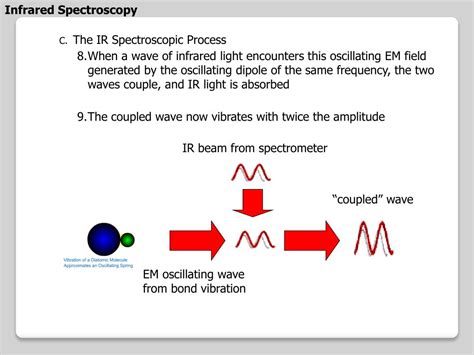principle of ir spectroscopy ppt|PPT : Tuguegarao This document provides an introduction to infrared (IR) spectrophotometry. It discusses how IR spectroscopy analyzes molecular vibrations when molecules absorb . q) Copy of Official Receipt (OR) issued by the PCSO Treasury Department for the payment of the non-refundable application fee of One Hundred Thousand Pesos (Php 100,000.00). Notes: 1. The requirements for the STL application shall be submitted directly at the PCSO Main Office, Conservatory Building, Mandaluyong City. The application Fee is Php

principle of ir spectroscopy ppt,This presentation gives you thorough knowledge about the IR Spectroscopy. This include basic principle, type of vibrations, factors influencing vibrational .This document provides an introduction to infrared (IR) spectrophotometry. It .The document summarizes infrared (IR) spectroscopy, including its principle, .
This document provides an introduction to infrared (IR) spectrophotometry. It discusses how IR spectroscopy analyzes molecular vibrations when molecules absorb . The document summarizes infrared (IR) spectroscopy, including its principle, instrumentation, applications, and interpretation of spectra. IR spectroscopy .principle of ir spectroscopy ppt • Infrared Spectroscopy (IR) – Triggering molecular vibrations through irradiation with infrared light. Provides mostly information about the presence or absence .6 IR Spectroscopy In IR spectroscopy, there is interaction between molecules and radiations from the IR region of the EMR spectrum (IR region = cm-1) IR radiation . IR spectroscopy is the study of the interactions between infrared electromagnetic energy and matter, and allows for qualitative and quantitative .IR spectroscopy probes vibrational transitions and provides information about functional groups. The document outlines general trends in IR absorption such as stronger bonds .3 INFRARED ABSORPTION SPECTRUM. 4 INTRODUCTION TO INFRARED SPECTROMETRY.PPT IR Spectroscopy • IR is used to measure the vibrational frequencies of bonds in the molecule. • Bonds are not rigid. A bond can be viewed as a spring with a weight at each end. • Each bond has a .
Infrared spectroscopy, also called IR spectroscopy, probes stretching and bending vibrations of organic molecules. 3 Fourier Transform Infrared Spectroscopy (FTIR) . This presentation gives you thorough knowledge about the IR Spectroscopy. This include basic principle, type of vibrations, factors influencing vibrational frequency, instrumentation and applications of IR Spectroscopy. This document provides an introduction to infrared (IR) spectrophotometry. It discusses how IR spectroscopy analyzes molecular vibrations when molecules absorb IR radiation that matches their natural vibrational frequencies.principle of ir spectroscopy ppt PPT The document summarizes infrared (IR) spectroscopy, including its principle, instrumentation, applications, and interpretation of spectra. IR spectroscopy works by detecting the vibrational and rotational absorption frequencies of molecules when exposed to IR radiation.
• Infrared Spectroscopy (IR) – Triggering molecular vibrations through irradiation with infrared light. Provides mostly information about the presence or absence of certain functional groups.6 IR Spectroscopy In IR spectroscopy, there is interaction between molecules and radiations from the IR region of the EMR spectrum (IR region = cm-1) IR radiation causes the excitation of the vibrations of covalent bonds within that molecule.
IR spectroscopy is the study of the interactions between infrared electromagnetic energy and matter, and allows for qualitative and quantitative measurements of samples.
IR spectroscopy probes vibrational transitions and provides information about functional groups. The document outlines general trends in IR absorption such as stronger bonds absorbing at higher energies. It also discusses the requirement of bond polarity for vibrations to be IR active.
3 INFRARED ABSORPTION SPECTRUM. 4 INTRODUCTION TO INFRARED SPECTROMETRY. IR Spectroscopy • IR is used to measure the vibrational frequencies of bonds in the molecule. • Bonds are not rigid. A bond can be viewed as a spring with a weight at each end. • Each bond has a characteristic frequency. • The IR scans a range of frequencies (in the infrared part of the electromagnetic spectrum).
Infrared spectroscopy, also called IR spectroscopy, probes stretching and bending vibrations of organic molecules. 3 Fourier Transform Infrared Spectroscopy (FTIR) identifies chemical bonds in a molecule by producing an infrared absorption spectrum. This presentation gives you thorough knowledge about the IR Spectroscopy. This include basic principle, type of vibrations, factors influencing vibrational frequency, instrumentation and applications of IR Spectroscopy.
This document provides an introduction to infrared (IR) spectrophotometry. It discusses how IR spectroscopy analyzes molecular vibrations when molecules absorb IR radiation that matches their natural vibrational frequencies.

The document summarizes infrared (IR) spectroscopy, including its principle, instrumentation, applications, and interpretation of spectra. IR spectroscopy works by detecting the vibrational and rotational absorption frequencies of molecules when exposed to IR radiation.

The document summarizes infrared (IR) spectroscopy, including its principle, instrumentation, applications, and interpretation of spectra. IR spectroscopy works by detecting the vibrational and rotational absorption frequencies of molecules when exposed to IR radiation. • Infrared Spectroscopy (IR) – Triggering molecular vibrations through irradiation with infrared light. Provides mostly information about the presence or absence of certain functional groups.6 IR Spectroscopy In IR spectroscopy, there is interaction between molecules and radiations from the IR region of the EMR spectrum (IR region = cm-1) IR radiation causes the excitation of the vibrations of covalent bonds within that molecule.
IR spectroscopy is the study of the interactions between infrared electromagnetic energy and matter, and allows for qualitative and quantitative measurements of samples.
IR spectroscopy probes vibrational transitions and provides information about functional groups. The document outlines general trends in IR absorption such as stronger bonds absorbing at higher energies. It also discusses the requirement of bond polarity for vibrations to be IR active.3 INFRARED ABSORPTION SPECTRUM. 4 INTRODUCTION TO INFRARED SPECTROMETRY.
principle of ir spectroscopy ppt|PPT
PH0 · Theory of IR spectroscopy
PH1 · PPT
PH2 · Lecture 3 INFRARED SPECTROMETRY
PH3 · Introduction and Principle of IR spectroscopy
PH4 · Infrared Spectroscopy Theory and Interpretation of IR spectra
PH5 · IR Spectroscopy Basics
PH6 · IR Spectroscopy
PH7 · Fourier transform infrared spectroscopy [FTIR]